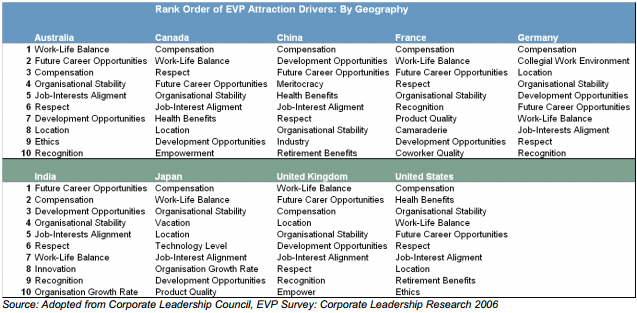Do You Know What Your Employer Value Proposition Is?

Have you ever been asked this question at a conference yet failed to come up with an instant, convincing answer? When answering this question, do your listeners’ eyes glaze over as you stumble around looking for a clear, substantive message, but actually deliver tired out cliches and shallow statements that impress no one, least of all yourself? I bet the Google, Zappos and P&G employer super brands don’t struggle with that question.
So, if you really can’t answer this question succinctly and confidently (and a recent survey from Towers Watson tells us that just 43 percent of employers are deploying their EVP effectively), then it’s time to take action. Why? Because, many studies have shown that an effective EVP can drive performance. For example, the Towers Watson survey mentioned above has revealed that employers who use their EVP effectively are five times more likely to report their staff is highly engaged and twice as likely to report financial performance achievements, which are much higher than their peers with a less effectively deployed EVP.
Also, a study by the Corporate Leadership Council shows that employers with an “unattractive” EVP require a 21 percent salary premium to attract candidates, but those with “attractive” EVPs only require a 10 percent premium, i.e. an effective EVP will help you to attract staff and could reduce your salary bill.
So, what steps do employers need to take to create or enhance their EVP? Ideally, they need to start by understanding what the key EVP attraction drivers are in their geography or industry. A good way to find out this information is to ask and survey your staff and candidates for their views, but I’d also take a look below at this excellent summary of EVP attraction drivers, page 13 of the Manpower White Paper, The Power of Employment Value Proposition. It was adapted from the Corporate Leadership Council, EVP Survey: Corporate Leadership Research 2006.
It sets out the EVP Attraction Drivers of the nine major economies based on its research of over 58,000 new hires and employees in 90 firms across 34 countries and 20 industries. Based on where you are located, you can easily deduce what the EVP attraction drivers are, e.g. which employer offerings will be most attractive to your staff potentially. For example, in the U.S., the top four EVP attraction drivers are Compensation, Health Benefits, Organizational Stability and Work-Life Balance; while in the UK, Work-Life Balance tops the charts with Compensation coming in third. In India, Future Career Opportunities and Development Opportunities occupy two of the top four slots, showing the importance of upward mobility.
So, this chart represents a clear framework allowing you to prepare an EVP that matches employees’ needs as far as your resources permit. But, remember a strong EVP should drive down starting salaries significantly so see an investment with a return and not a mere expenditure. But, building your EVP is about more than just ticking boxes. Sure, the Tower Watson survey shows that 49 percent of effective EVPs are comprehensive and balanced, but it also found that 47 percent of highly effective EVPS were differentiated and stood out from the competition. An additional 44 percent of companies with highly effective EVPs actually help employees understand how individual needs are met.
If you work and implement an effective EVP, the next time you’re at the conference you’ll be able to describe your balanced, comprehensive, differentiated and well-communicated EVP in a precise concise and succinct way – and you can take comfort in the knowledge that your organization is more effective as a result.


